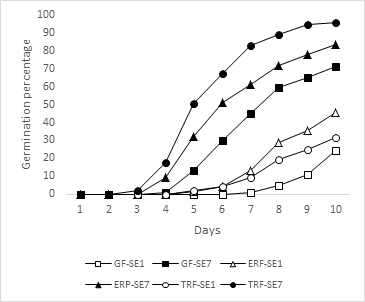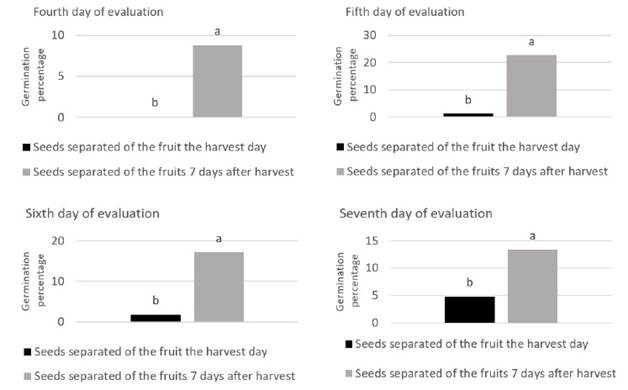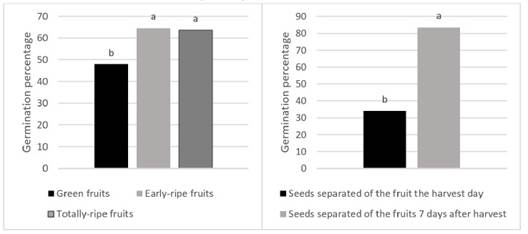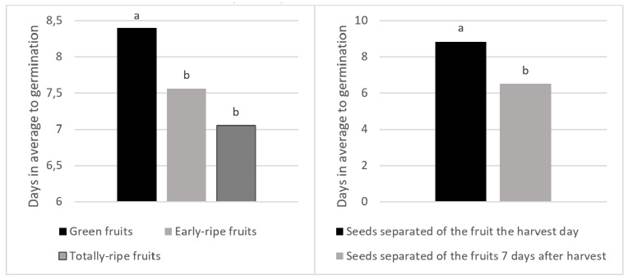INTRODUCTION
Pepper (Capsicum chinense Jacq.) is a species belonging to the plant family Solanaceae, which comprises herbaceous and perennial plants. This species domesticated in Amazonas basin [1], is grown and consumed in many parts of the world. It is worldwide recognized for the fruit pungency, especially by cultivar “Habanero”, however, C. chinense has a large genetic diversity [2], mainly in South America, including many non-pungent types. For these authors, Venezuelan accessions present a high genetic variability, therefore this country is considered as diversity center of the crop. Venezuelan cuisine is characterized by the flavor given by fruits of C. chinense [3], which belong to the non-pungent types. It is named “sweet pepper” in this country to differentiate it of the pungent types “chilli pepper”. It is used for sauce and stew elaboration for meats and fishes. Despite of the great importance of this kind of “sweet pepper” in Venezuela, there is a little knowledge about the crop. Some studies about horticultural management have been carried out, such as transplant time [4], pruning [5], disease control [6], irrigation [7], however, there is a little knowledge about seed in this species [8], and there is no previous studies about seed germination in this Venezuelan type of C. chinense except the carried out for evaluating priming with potassium nitrate [9].
Knowledge of the conditions required for maximum germination is an important key fact to optimize plantlets production. Farmers complain about low and uneven germination for C. chinense [9], observation indicated not only for this species, but also for the five domesticated species of Capsicum genus [10]. High, fast, and uniform germination is desirable for planning production, therefore is necessary to get information for optimizing germination process. Seed germination in Capsicum genus is influenced by dormancy [11], and seed development [12], among others factors. Seed pre-conditioning, and priming are some of the strategies used for increasing germination in Capsicum genus [10, 13, 14, 15], however, for C. chinense is not known if seed development, as consequence of moment of fruit harvest and moment of seed extraction of the fruit, could be the cause of poor germination. These aspects are necessary to know them in order to be more precise to design strategies to optimize germination in “sweet pepper” C. chinense.
The objective of this research was to determine the influence of fruit ripening, and seed extraction from the fruit, on germination percentage and number of days to germination of one variety of the Venezuelan type of C. chinense called “sweet pepper”.
METHOD
Plant material
Thirty plantlets of “sweet pepper” of C. chinense species, belonging to the cultivar “Rosita” were obtained from a recognized nursery in Quibor, Lara state, Venezuela. These plantlets were transplanted individually in bags containing 3000 cm3 of substrate (sand and clay soil 1:1). They were irrigated twice a week until fruits used for the experiment were obtained.
Seeds extraction
Each plant was considered suitable to get fruits for the experiment after 3 fruits were totally developed at the plant, which occurred around the day 45 since the transplant date. Fruits for each plant were harvested in the following way: two just when on the green fruit appeared the first light green line (these fruits were called green fruits), two when half of the fruit was yellow and the other half remained green (these fruits were called early-ripe fruits), and the last two ones just when fruits became totally yellow (these fruits were called totally-ripe fruits). At the end, sixty green fruits, sixty early-ripe fruits, and sixty totally ripe fruits had been harvested. For each of the three fruit categories, half of the fruits were opened and seeds were taken (these seeds were called seeds extracted at day 1), and half of the fruits remained at room temperature (about 28°C) and were opened 7 days after harvest to obtain the seed (these seed were called seeds extracted at day 7). Fruit harvest and seed extraction were synchronized to start germination tests for all the treatments at the same day, it means, a day named day 0 were harvested 30 green fruits, 30 early-ripe fruits, and 30 totally ripe fruits, for all these fruits seeds were kept inside of the fruits. At the day named day 8 were harvested 30 green fruits, 30 early-ripe fruits, and 30 totally ripe fruits, and seeds were extracted from these fruits; furthermore seeds were collected from fruits harvested at the day 0.
Experiment design
A completely random experiment design with six treatments and ten replication was established in Agua Viva (512 meter on sea level, average temperature of 26°C, average relative humidity of 75%), Palavecino Municipality, Lara state, Venezuela. The treatment design was a factorial 3x2, where main factors were Maturation of the Fruit and Extraction Moment of the Seed, the first one with three levels (green fruits, early-ripe fruits, and totally ripe fruits), and the second one with two levels (seeds separated at day 1, and seeds separated at day 7). Experimental units were germination chambers (anime trays 20 x 12 cm as support of paper towel, covered with transparent plastic cover 10 cm height), one per replication, containing 100 seeds recorded for germination.
Germination tests
One hundred seeds for each experimental unit were used for germination tests. Seeds were placed in germination chambers at room temperature (about 27°C in average). Germination was recorded for each experimental unit during 10 days, so close to the period used by Hernandez et al. (2019) [16] for evaluating germination in C. chinense. Germination percentage for each day, and over the ten days, was calculated. Seeds were considered germinated when the radicle emerged. Number of days to germination, was calculated as a weighted average according the amount of seeds germinated at each day.
Data analysis
Variance analysis were performed for germination each day and over all the days, and also for number of days to germination; considering the main factors and their interaction. Variables resulting in statistical differences were subjected to Tukey mean test. All the statistical analyses were performed with Statistix for Windows v. 8.0.
RESULTS
Evaluation of seed germination in six combinations between three fruit maturation stages and two moments of seed extraction from the fruits resulted in data showed in Figure 1. Germination started at day 3 for seeds coming from totally-ripe fruits and separated at day 7 Interaction for Maturation of the Fruit and Separation Moment of the Seed did not show significant differences (P>0,05) neither for Germination Percentage (for each day or over all the days) nor for Number of Days to Germination. Germination percentage for fourth, fifth, sixth, and seventh day of evaluation showed differences (P<0,01) only for Moment of Seed Separation: germination for seeds separated of the fruit at day 7 was in average 10-fold higher (P<0,01) than germination percentage of seeds separated of the fruits at day 1 (Figure 2). Germination percentage accumulated on the ten days of evaluation displayed statistical differences (P<0,01) for both main factors (Figure 3); totally- and early-ripe fruits had germination over 60% while green fruits did not reach 50%. Seeds separated 7 days after fruits harvest had more than 80% of germination, while seeds separated the same day of the fruits harvest reached only 34% of germination. Number of days to germination resulted also with differences (P<0,01) for the main factors evaluated (Figure 4). While seeds obtained from green fruit germinated in 8,40±1,49 days, seeds obtained from early-ripe fruits germinated in 7,56±1,48 days, and from totally-ripe fruits in 7,05±1,66 days. More evident for number of days to germination is the effect of moment of seed separation of the fruits: 6,50±1,28 days for seeds separated from the fruits at day 7 after harvest, and 8,75±0,94 for seeds separated from the fruit the same day of the harvest.

Figure 1 Germination percentage for six treatments in a Venezuelan type of “sweet pepper” C. chinense during 10 days (GF is green fruits, ERF is Early Ripe Fruits, TRF is Totally Ripe Fruits, SE1 is Seed Extracted from the Fruit at Day 1, SE7 is Seeds Extracted from the Fruit at Day 7).

Figure 2 Germination percentage for seeds separated of the fruit at the harvest day, and 7 days after harvest, at fourth, fifth, sixth, and seventh day of germination evaluation. Means represented with different letters showed statistical differences (P<0,01).

Figure 3 Germination percentage after ten days of evaluation, for three maturation stages of the fruit, and two moments of seed separation of the fruits. Means represented by the same letter does not have statistical differences (P>0,05)

Figure 4 Days in average to germination after ten days of evaluation, for three maturation stages of the fruit, and two moments of seed separation of the fruits. Means represented by the same letter does not have statistical differences (P>0,05)
Production of high quality seeds depends, among several factors, on appropriate harvest time [17]. Results of the present work indicate that percentage of seed germination and number of days to germination in C. chinense is affected by ripening of the fruits, and moment of seed separation from the fruit. Complain of farmers about uneven germination and low germination percentage [9, 10] could be caused by lack of uniformity in ripening level of fruits harvested to get seeds, and/or lack of uniformity in moment of seed separation from the fruits. Most of the attempts to overcome the problem of low germination percentage in C. chinense and other species of the genus Capsicum have been based in use of adequate substrates [18], priming strategies [9, 10, 12], or studies about optimal seed storage [19], however, there is no reports about systematic comparison among germination percentages and number of days to germination of seeds coming from different ripening fruits levels or different moment of seed separation from the fruits. According to results of this research, green fruits should not be harvested to get seeds due to the low germination percentage and higher number of days to germination. Low germination percentage in immature fruits of C. chinense is due to the absence of some reserve substances in the seeds caused by insufficient physiological maturity [20]. To harvest early-ripe fruits, or totally-ripe fruits has the same effect on germination percentage and number of days to germination, increasing germination percentage in about 15% as compared to seeds coming from green fruits; and accelerating the time to obtain germination in about 1 day (from 8,4 days in green fruits to 7,3 days in early- and totally-ripe fruits). Maximum germination of seeds in the period of 71-81 days after anthesis was found in pepper (Capsicum baccatum) seeds [17]; this result differs as compared to results of present work, where maximum germination occurred with early-ripe fruits, and this fruit state occurred about day 55 after anthesis.
Fruits and therefore seeds of these species are consumed by birds, and digestive tract acts on seed to become them suitable for germination [21]. It is possible that, if seeds are kept inside the fruits as in the present research, they are subjected to the action of some fruit metabolites which appear after fruit is harvested, it means, when decomposition of the fruit starts, giving the opportunity to become the seed ready to germinate, in a similar way as bird digestive tract acts on the seeds of C. chinense. This theory could explain the fact that seeds separated from the fruit 7 days after harvest had higher germination percentage and faster germination speed than seed which did not have the chance to be subjected to the action of the fruit metabolites. Exogenous capsaicin application (0,1 ppm) to seeds of C. annuum increased germination percentage and shortened germination time [22], and, considering that the type of Venezuelan “sweet pepper” evaluated in the present work belongs to the genus Capsicum, it could be possible that minimal levels of capsaicin are produced in the fruit and affect percentage and speed of germination. Capsaicinoids levels and maximum amount produced depends, among other factors, on C. chinense cultivar or accessions, and they increases according to ripening of the fruit [23]. Water stress increases levels of capsaicinoids in C. chinense, [24] and it occurs when fruits are separated from the plant, therefore, it is a possible explanation about faster germination and higher germination percentage in the present work.
CONCLUSIONS
There is not statistical interaction between ripening fruits levels and moment of seed separation from the fruits when germination percentage and number of days to germination were evaluated in Capsicum chinense cultivar Rosita, however, there are effect of these factors individually. Seeds extracted from green fruits had lower germination percentage (48%) and lower germination speed (8,40 days) than seeds coming from early- (65% of germination, 7,56 days to germination) and totally-ripe fruits (64% of germination, 7,05 days to germination). Seeds separated from the fruit 7 days after harvest had higher germination percentage (83% and 6,50 days) and faster germination speed than seeds separated of the fruits the same day of the harvest (34% and 8,75 days).














